Zimbabwean Culinary Adventures: Savory Okra, Timeless Sadza, Exotic Mopane Worms, and Succulent Cow Feet
Overview:
Unlike some other African regions where okra is often mixed with fish and exotic meats, the Zimbabwean traditional okra recipe is characterized by its simplicity and economic use of minimal ingredients. This quick and easy dish is perfect for those seeking a flavorful yet uncomplicated meal.

Ingredients:
- 250g derere (okra/lady’s fingers)
- 1 onion (chopped)
- 2 tomatoes (chopped)
- 2 cloves garlic (minced)
- 1 tablespoon cooking oil
- Salt and pepper to taste
- Optional: chili pepper (for added heat)

Instructions:
- Wash the derere thoroughly under cold water and pat them dry with a paper towel. Trim off the stems and ends, then slice the derere into rounds.
- Heat the cooking oil in a pan over medium heat. Add the chopped onion and minced garlic, and sauté until the onion is soft and translucent.
- Add the chopped tomatoes to the pan and cook until they start to soften and release their juices.
- Add the sliced derere to the pan and stir well to combine with the onion and tomato mixture. If using chili pepper, add it now.
- Cook the derere for about 10-15 minutes, stirring occasionally, until they are tender but still slightly crisp.
- Season the derere with salt and pepper to taste, adjusting the seasoning as needed.
- Once the derere are cooked to your liking, remove the pan from the heat and serve the dish hot as a side dish or as part of a main meal.
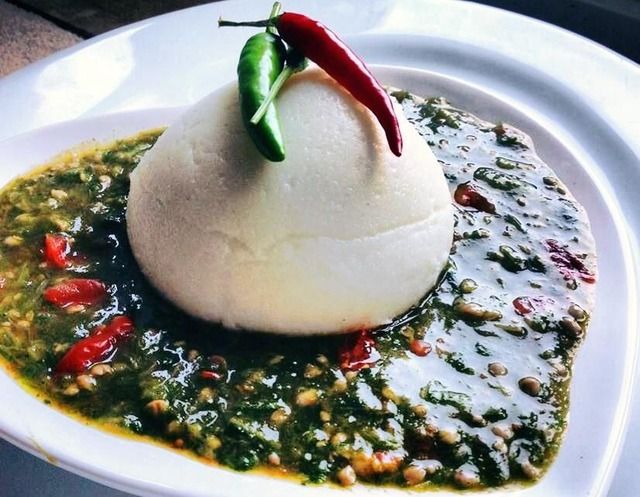
Enjoy your delicious derere as a nutritious and flavorful addition to your Zimbabwean-inspired meals!
Conclusion:
With just a handful of simple ingredients and a short cooking time, this Zimbabwean okra recipe showcases the beauty of uncomplicated and budget-friendly cooking. Whether enjoyed as a standalone dish or paired with other traditional favorites, this flavorful okra preparation is sure to become a staple in your culinary repertoire.

Sadza/Ugali: Zimbabwean Staple Dish
Overview:
Sadza, also known as Ugali, is a staple food in many African countries, particularly South Africa and East Africa. It is a hearty and filling dish made from finely ground white cornmeal, commonly referred to as mealie meal.
Texture and Preparation:
Sadza has a thick and dense texture, similar to polenta but with a thicker consistency. It is prepared by cooking the cornmeal with water until it reaches a smooth and thick porridge-like consistency. The cooking process requires continuous stirring to prevent lumps from forming.
Culinary Usage:
Sadza/Ugali is typically served as an accompaniment to meat dishes, vegetable soups, and stews. It serves as a carbohydrate base that complements the flavors of the main dish. In many African households, it is considered a filling and satisfying meal when paired with a variety of meats and vegetables.
Variations and Names:
While Sadza is the commonly used term in Zimbabwe, it goes by different names in other African countries. In South Africa, it is referred to as pap, while in Tanzania and Uganda, it is known as Ugali and Posho, respectively. Other names for this dish include Nshima (Zambia), mielie pap (South Africa), and nsima (Malawi). Despite the varying names, the basic preparation and ingredients remain similar across regions.
Cultural Significance:
Sadza/Ugali holds significant cultural importance in African cuisine, symbolizing community, togetherness, and tradition. It is often shared during communal meals and celebrations, fostering a sense of unity and belonging among family and friends.

Here’s a simple recipe for making sadza/pap:
Ingredients:
- 2 cups of white maize meal (cornmeal)
- 4-5 cups of water
- Salt (optional)
Instructions:
- In a large, heavy-bottomed pot, bring the water to a boil over medium-high heat.
- Once the water is boiling, gradually add the maize meal to the pot, stirring constantly with a wooden spoon or whisk to prevent lumps from forming.
- Continue stirring the mixture until it thickens and starts to bubble.
- Reduce the heat to low and cover the pot with a lid. Let the sadza simmer for about 30-40 minutes, stirring occasionally to prevent it from sticking to the bottom of the pot.
- After 30-40 minutes, the sadza should be thick and smooth in texture. If it’s too thick, you can add a little more water and continue cooking until it reaches the desired consistency.
- Taste the sadza and add salt if desired, stirring well to incorporate.
- Once the sadza is cooked and seasoned to your liking, remove it from the heat and let it sit for a few minutes before serving.
- Serve the sadza hot alongside your favorite Zimbabwean dishes, such as stews, vegetables, or meat.
Enjoy your homemade sadza/pap as a comforting and satisfying staple food, perfect for sharing with family and friends!
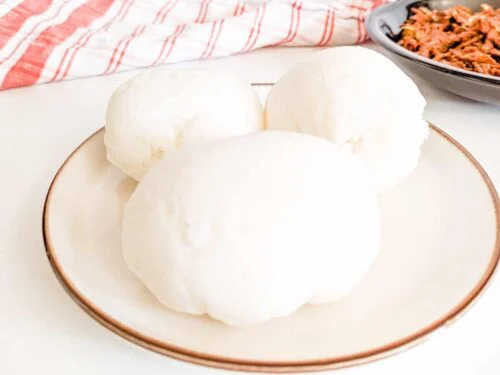
Conclusion:
Whether enjoyed in Zimbabwe as Sadza or in Tanzania as Ugali, this simple yet hearty dish remains a beloved culinary tradition across Africa. Its versatility and comforting texture make it a cherished part of the African culinary heritage, reflecting the richness and diversity of the continent’s cuisine.
Zimbabwean Cuisine: Mopane Worm Delicacy, Its History and Recipe
Cultural Delicacy:
Mopane worms, known as ‘amancimbi’ in Ndebele or ‘madora’ in Shona, hold a special place in Zimbabwean cuisine as a cherished delicacy. Despite initial hesitations from some, these worms are celebrated for their unique taste and nutritional value.
Source of Protein:
Harvested from the mopane woodlands of southern Africa, mopane worms are actually large caterpillars of the Emperor moth (Gonimbrasia belina). They feed on the leaves of mopane trees, hence their name, and have been a vital source of protein for generations across Southern Africa.

Historical Significance:
While there is no documented history of mopane worm consumption in Zimbabwe, archaeological discoveries suggest its consumption dates back thousands of years. Dried mopane worms found in ancient pits at Pomongwe Cave in Zimbabwe indicate their importance as a food source for early inhabitants.
Economic Importance:
According to the Food and Agriculture Organization (FAO), mopane worms are economically significant forestry resources, particularly in southern Zimbabwe, Botswana, and northern South Africa. Annually, billions of mopane larvae are harvested, contributing millions of dollars to the local economy.
Nutritional Value:
Mopane worms are not only valued for their taste but also for their nutritional benefits. Rich in protein and other essential nutrients, they provide sustenance to communities, especially in rural areas.
Cooking Methods:
Mopane worms are typically harvested during the rainy season, cleaned, and sun-dried for preservation. They can be enjoyed in various ways:
- Crispy and dry as a snack.
- Drenched in sauce or added to maize porridge.
- Fried with tomatoes, garlic, peanuts, chillies, and onions.
- Added to stews or boiled to soften them.
- Eaten raw for a unique and undiluted flavor experience.
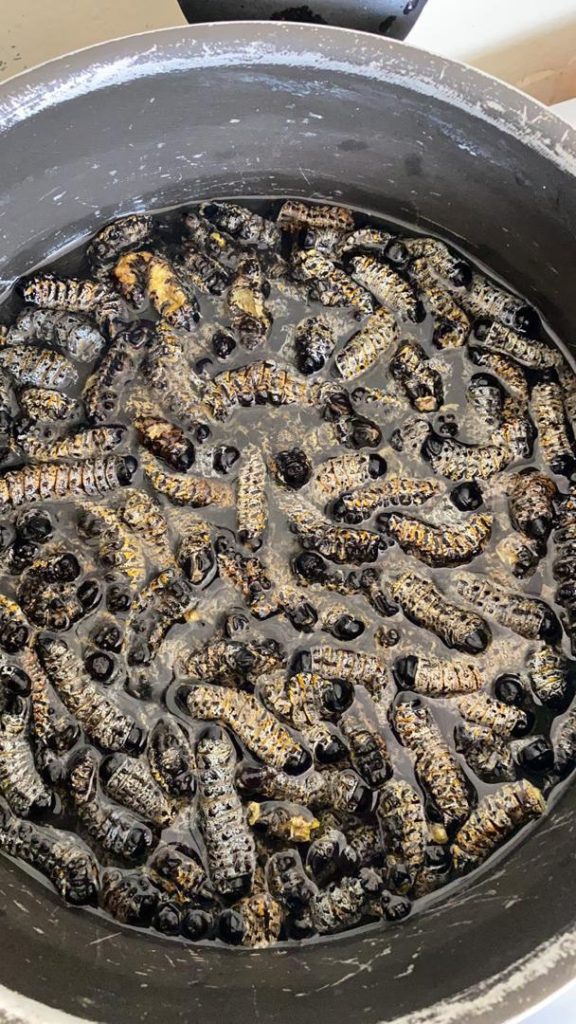
Culinary Exploration:
For those curious about this traditional delicacy, recipes for cooking mopane worms can be found online, offering a glimpse into the rich culinary heritage of Zimbabwe.
Embrace the cultural and culinary richness of Zimbabwe with a taste of mopane worms, a delicacy that transcends generations and celebrates the bounty of nature’s offerings.
Here’s a simple recipe for preparing mopane worms:
Ingredients:
- Dried mopane worms (available in most African markets)
- Cooking oil
- Salt
- Optional: onion, tomato, garlic, chili pepper (for added flavor)
Instructions:
- If the mopane worms are dried, soak them in water for a few hours or overnight to rehydrate them.
- Once rehydrated, drain the mopane worms and rinse them thoroughly under cold water.
- Heat some cooking oil in a frying pan over medium heat.
- If using, add chopped onion, tomato, garlic, and chili pepper to the pan and sauté until softened.
- Add the rehydrated mopane worms to the pan and cook for 5-10 minutes, stirring occasionally, until they are heated through.
- Season the mopane worms with salt to taste.
- Serve the mopane worms hot as a snack or as part of a meal, traditionally accompanied by sadza (a staple maize meal) or rice.
Enjoy your delicious madora (mopane worms) as a unique and flavorful Zimbabwean dish!
Zimbabwean Cuisine: Cow Feet Delicacy
Historical Significance:
Cow feet have been a staple in the Zimbabwean diet for generations, deeply rooted in tradition and cultural practices. Historically, consumption of cow feet was restricted to men, believed to enhance their virility. However, modern times have seen a shift, allowing women to also indulge in this savory delicacy.
Traditional Slaughtering Process:
In many rural areas of Zimbabwe, families engage in traditional animal slaughtering practices, ensuring nothing goes to waste. After slaughtering, the cow’s head, offal, and feet are meticulously cleaned and prepared. The cow’s hide is preserved and dried for use as mats, while the cow feet are left with their skin intact, as it is considered part of the flavorful meat.
Cleaning and Preparation:
Cleaning cow feet involves two main methods: pouring boiling water over them to remove hair from the hide or placing them over hot flames. Once cleaned, the hooves are removed, and the feet are either cut into pieces by a butcher or with the use of an axe.
Cooking Process:
Cooking cow feet is a laborious process, as it primarily involves simmering the meat, including the hide, until tender. The slow cooking process allows the flavors from the bones to infuse into the dish. Traditional recipes often involve minimal seasoning, with some opting for simplicity by boiling the feet in water and salt alone.
Acquired Taste and Cultural Significance:
Cow feet are known for their acquired taste, appreciated by those who enjoy the unique texture and rich flavors. Despite being an acquired taste, they hold significant cultural importance, representing a connection to heritage and traditional cuisine.
Modern Perspectives:
While traditional practices persist, modern Zimbabwean cuisine continues to evolve, with variations in cooking methods and flavor profiles. Cow feet remain a cherished dish, cherished for its cultural significance and savory flavors, enjoyed by families across the country.
Indulge in the rich culinary heritage of Zimbabwe with a taste of tender cow feet, a dish that encapsulates tradition, flavor, and cultural pride.
Here’s a simple recipe for Mazondo (Cow Foot), a popular Zimbabwean dish:
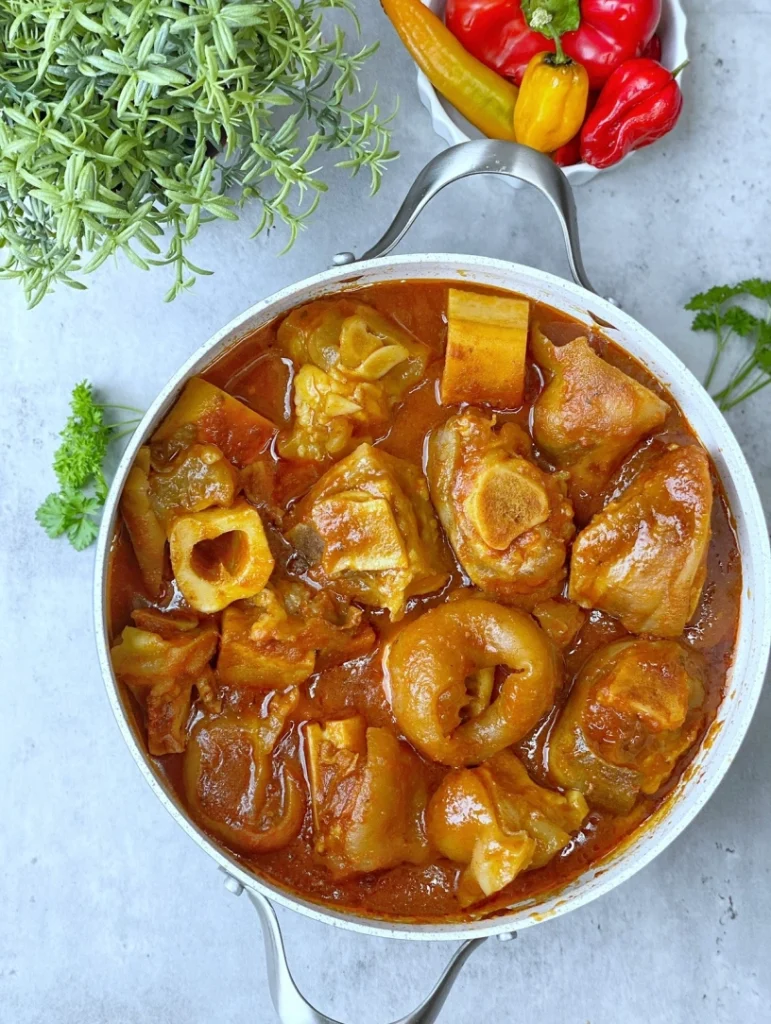
Ingredients:
- 2 cow feet (cleaned and chopped)
- 2 onions (chopped)
- 2 tomatoes (chopped)
- 2 cloves of garlic (minced)
- 1 tablespoon of tomato paste
- 2 tablespoons of cooking oil
- 1 teaspoon of curry powder
- Salt and pepper to taste
- Water
- Optional: chopped fresh coriander for garnish
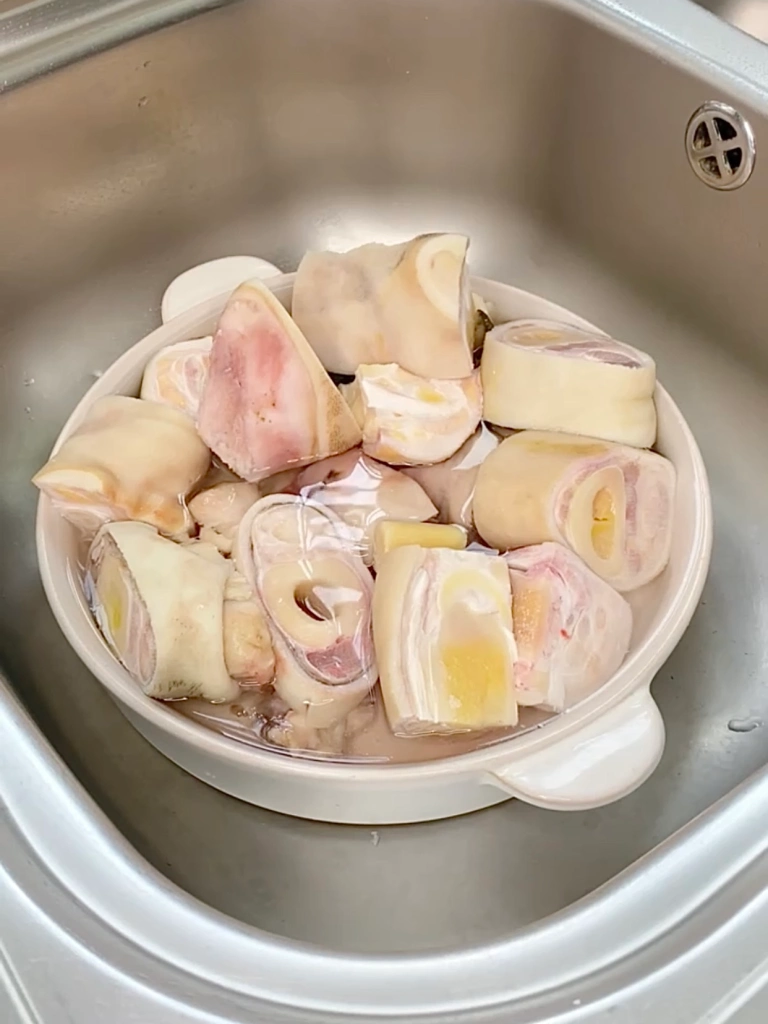
Instructions:
- In a large pot, heat the cooking oil over medium heat. Add the chopped onions and minced garlic, and sauté until the onions are soft and translucent.
- Add the chopped tomatoes and tomato paste to the pot, and cook until the tomatoes have softened and released their juices.
- Stir in the curry powder, salt, and pepper, and cook for another minute to allow the flavors to blend.
- Add the chopped cow feet to the pot, and stir well to coat them with the tomato mixture.
- Pour enough water into the pot to cover the cow feet, and bring the mixture to a boil.
- Once boiling, reduce the heat to low, cover the pot, and simmer for about 2-3 hours, or until the cow feet are tender and falling off the bone. You may need to add more water during cooking if the mixture becomes too thick.
- Once the cow feet are cooked, remove them from the pot and place them on a serving dish.
- Serve the Mazondo hot, garnished with chopped fresh coriander if desired.

Enjoy your delicious Mazondo (Cow Foot) with sadza or rice for a traditional Zimbabwean meal!
Mupunga Unedovi: A Zimbabwean Traditional Delicacy
Introduction:
Mupunga Unedovi is a beloved traditional dish originating from Zimbabwe. Simple yet flavorful, it is cherished for its humble ingredients and comforting taste. This dish exemplifies the resourcefulness and culinary ingenuity of Zimbabwean cuisine.
Ingredients:
- Long grain rice
- Peanut butter
- Salt
- Water
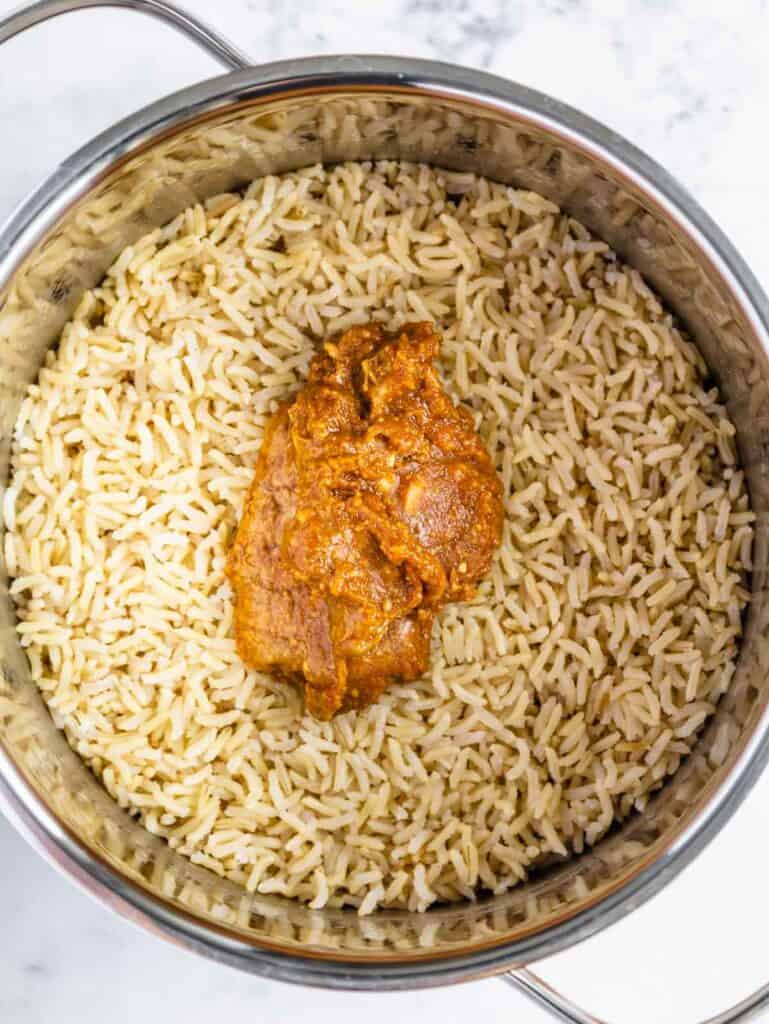
Preparation:
- Rinse the long grain rice thoroughly under cold water to remove any impurities. Drain well.
- In a large pot, combine the rinsed rice with water, ensuring that there is enough water to fully cover the rice.
- Bring the water to a boil over medium-high heat, then reduce the heat to low and let the rice simmer until it absorbs most of the water and becomes tender. Stir occasionally to prevent sticking.
- Once the rice is cooked and has absorbed the water, add a generous dollop of peanut butter to the pot. The amount of peanut butter can be adjusted according to personal preference.
- Stir the peanut butter into the rice mixture, ensuring that it is evenly distributed. If the mixture appears too thick, add a splash of water to achieve the desired consistency.
- Season the dish with salt to taste, adjusting the amount according to personal preference.
- Allow the rice and peanut butter mixture to simmer together for a few more minutes, allowing the flavors to meld and the rice to become slightly overcooked. This helps to create a creamy and cohesive texture.
- Once cooked to perfection, remove the pot from the heat and let it sit for a few minutes to allow the flavors to settle.
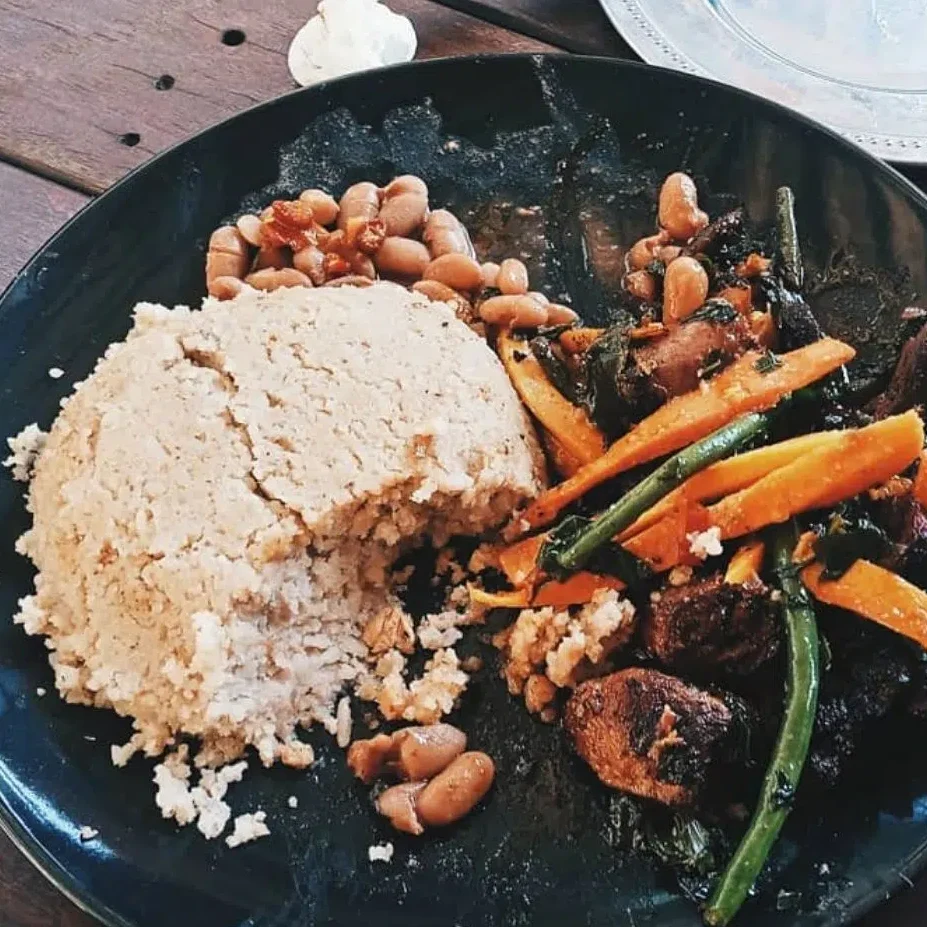
Serving Suggestions:
- Mupunga Unedovi is traditionally served alongside a variety of meat stews and sauces, such as beef, chicken, or vegetable-based curries.
- Leftovers can be enjoyed the next day, reheated and served with a cup of tea for a comforting and satisfying meal.
Conclusion:
Mupunga Unedovi is a testament to the beauty of simplicity in cooking. With just three basic ingredients, this Zimbabwean delicacy offers a delightful combination of flavors and textures. Whether enjoyed as a standalone dish or paired with hearty accompaniments, Mupunga Unedovi is sure to become a cherished part of any mealtime tradition.
Related Article Zimbabwean Mushroom Magic: Nhedzi Soup, Mutakura, and Fried Button Mushroom Recipes


